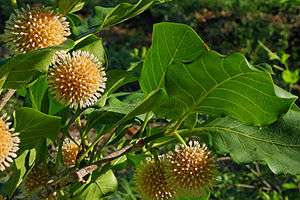Nauclea
Nauclea is a genus of flowering plants in the family Rubiaceae. The species are evergreen trees or shrubs that are native to the paleotropics.[1] The terminal vegetative buds are usually strongly flattened.[2] The generic name is derived from the Ancient Greek words naus, meaning "ship" and kleio, meaning "to close".[3] It refers to the resemblance of the cells of the capsule to a ship's hull.[4]
| Nauclea | |
|---|---|
 | |
| Nauclea orientalis | |
| Scientific classification | |
| Kingdom: | Plantae |
| Clade: | Tracheophytes |
| Clade: | Angiosperms |
| Clade: | Eudicots |
| Clade: | Asterids |
| Order: | Gentianales |
| Family: | Rubiaceae |
| Subfamily: | Cinchonoideae |
| Tribe: | Naucleeae |
| Genus: | Nauclea L. |
| Type species | |
| Nauclea orientalis | |
| Synonyms | |
| |
Cultivation and use
Nauclea diderrichii is a large tree from West Africa that is widely cultivated elsewhere.[5] Its wood is resistant to borers and is used around harbors and in other places where wood is in constant contact with water.[1]
Taxonomy
Nauclea is a member of the tribe Naucleeae and is sister to a clade consisting of Burttdavya and Sarcocephalus.[6] The current type species for the genus is Nauclea orientalis. Linnaeus originally named it Cephalanthus orientalis in the first edition of Species Plantarum but transferred it to Nauclea when he erected that genus in the second edition in 1762.[7]
Species
- Nauclea diderrichii (De Wild.) Merr.
- Nauclea gageana (King)
- Nauclea gilletii (De Wild.) Merr.
- Nauclea latifolia Smith
- Nauclea officinalis (Pierre ex Pit.) Merr. & Chun
- Nauclea orientalis (L.) L. - Common names: Kanluang, Bangkal, Leichhardt Tree, Cheesewood, Yellow Cheesewood, Canary Cheesewood
- Nauclea parva (Havil.) Merr.
- Nauclea robinsonii Merr.
- Nauclea subdita (Korth.) Steud. - Common names: Bongkol, Bulubangkal
- Nauclea tenuiflora (Havil.) Merr.
- Nauclea vanderguchtii (De Wild.) E.M.A.Petit
- Nauclea xanthoxylon (A.Chev.) Aubrév.
References
- Mabberley DJ (2008). Mabberley's Plant Book (3 ed.). Cambridge University Press. ISBN 978-0-521-82071-4.
- Ridsdale CE (1978). "A revision of the tribe Naucleeae s.s. (Rubiaceae)". Blumea. 24 (2): 325–331.
- Quattrocchi U (2000). CRC World Dictionary of Plant Names. 3. Baton Rouge, New York, London, Washington DC: CRC Press. ISBN 978-0-8493-2673-8.
- Huxley AJ (1992). Huxley AJ; Griffiths M; Levy M (eds.). The New Royal Horticultural Society Dictionary of Gardening. London: The Macmillan Press Limited. ISBN 978-0-333-47494-5.
- Staples GW, Herbst DR (2005). A Tropical Garden Flora. Honolulu: Bishop Museum Press.
- Manns U, Bremer B; Bremer (2010). "Towards a better understanding of intertribal relationships and stable tribal delimitations within Cinchonoideae s.s. (Rubiaceae)" (PDF). Molecular Phylogenetics and Evolution. 56 (1): 21–39. doi:10.1016/j.ympev.2010.04.002. PMID 20382247.
- Carolus Linnaeus. 1762. Species Plantarum 2nd edition. (Species plantarum : exhibentes plantas rite cognitas ad genera relatas, cum diferentiis specificis, nominibus trivialibus, synonymis selectis, locis natalibus, secundum systema sexuale digestas / Caroli Linnæe.): 1:243. Holmiae: Impensis Laurentii Salvii: Stockholm, Sweden.